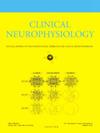Short-interval intracortical inhibition and facilitation in amyotrophic lateral sclerosis related to disease phenotype
IF 3.7
3区 医学
Q1 CLINICAL NEUROLOGY
引用次数: 0
Abstract
Objective
To investigate the relationship between short-interval intracortical inhibition (SICI), short-interval intracortical facilitation (SICF) and amyotrophic lateral sclerosis (ALS) phenotype, using threshold-tracking transcranial magnetic stimulation (TMS).
Methods
A new paired-pulse TMS protocol was applied to 49 patients with ALS and 49 age-matched healthy controls. Motor evoked potentials (MEPs) were recorded from first dorsal interosseus muscle, while paired pulses were delivered at interstimulus intervals (ISI) of 1.0, 2.5 or 3.0 ms, with stimuli related to the resting motor threshold for a 200 µV MEP. For each ISI, 6 SICI and 3 SICF pulse pairs with different conditioning stimuli were randomised and interleaved with test-alone stimuli.
Results
ALS phenotypes were characterised as Pyramidal (n = 12, with prominent upper motor neuron signs), Classic (n = 20, with limb onset), or Bulbar (n = 17). Compared with healthy controls, Bulbar patients had significantly less inhibition at all ISIs, while SICI in Pyramidal patients was normal, and in Classic patients intermediate. The only SICF abnormalities independent of the changes in SICI were less facilitation in Pyramidal patients at ISIs 1 and 3 ms.
Conclusion
Changes in SICI and SICF depend on ALS phenotype.
Significance
ALS phenotypes should be matched between treatment and placebo arms of clinical trials.
肌萎缩性侧索硬化症与疾病表型相关的短间隔皮质内抑制和促进
目的应用阈值跟踪经颅磁刺激(TMS)技术,探讨短间隔皮质内抑制(SICI)、短间隔皮质内促进(SICF)与肌萎缩侧索硬化症(ALS)表型的关系。方法对49例ALS患者和49例年龄匹配的健康对照者采用新的配对脉冲TMS方案。记录第一背骨间肌的运动诱发电位(MEP),并在刺激间隔(ISI) 1.0、2.5或3.0 ms时发送成对脉冲,刺激与200µV MEP的静息运动阈值相关。对于每个ISI, 6个SICI和3个SICF脉冲对具有不同的条件刺激被随机分配,并与单独的测试刺激交错。结果als的表型为锥体型(n = 12,有明显的上运动神经元征象)、经典型(n = 20,有肢体发病)和球型(n = 17)。与健康对照相比,球型患者在所有ISIs的抑制均显著降低,而锥体患者的SICI正常,经典患者的SICI为中等。唯一与SICI变化无关的SICF异常是在ISIs 1和3 ms时锥体型患者的易变性较差。结论SICI和SICF的变化依赖于ALS表型。临床试验中治疗组和安慰剂组的als表型应该匹配。
本文章由计算机程序翻译,如有差异,请以英文原文为准。
求助全文
约1分钟内获得全文
求助全文
来源期刊

Clinical Neurophysiology
医学-临床神经学
CiteScore
8.70
自引率
6.40%
发文量
932
审稿时长
59 days
期刊介绍:
As of January 1999, The journal Electroencephalography and Clinical Neurophysiology, and its two sections Electromyography and Motor Control and Evoked Potentials have amalgamated to become this journal - Clinical Neurophysiology.
Clinical Neurophysiology is the official journal of the International Federation of Clinical Neurophysiology, the Brazilian Society of Clinical Neurophysiology, the Czech Society of Clinical Neurophysiology, the Italian Clinical Neurophysiology Society and the International Society of Intraoperative Neurophysiology.The journal is dedicated to fostering research and disseminating information on all aspects of both normal and abnormal functioning of the nervous system. The key aim of the publication is to disseminate scholarly reports on the pathophysiology underlying diseases of the central and peripheral nervous system of human patients. Clinical trials that use neurophysiological measures to document change are encouraged, as are manuscripts reporting data on integrated neuroimaging of central nervous function including, but not limited to, functional MRI, MEG, EEG, PET and other neuroimaging modalities.
 求助内容:
求助内容: 应助结果提醒方式:
应助结果提醒方式:


